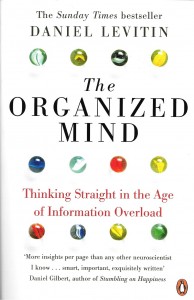The one sentence summary
Shift the burden of organizing to the external world, thereby freeing up thinking capacity.
WHAT THE BOOK SAYS 
There are four components in the human brain’s attentional system:
1. The Mind-Wandering mode – daydreaming, great for creativity
2. The Central Executive mode – to focus and stay on task
3. The Attentional Filter – purrs along, screening out irrelevant stimuli
4. The Attentional Switch – operates in background, moves between modes
- Attention is a limited capacity resource. Switching attention comes at a high cost. Multitasking is now proven not to work. Once on a task, our brains work best if we stick to that task: it pays to uni-task.
- Even the opportunity to multitask is a distraction: the very presence of unread email can reduce your IQ by 10 points. We all suffer from novelty bias, and in multitaskers this becomes an addiction loop.
- Email bankruptcy is declaring openly that you will never catch up – usually via an auto reply saying that all past communication has been archived, and if anything is now important, please send it again.
- Some people suffer from a chronic inability to finish projects. Procrastination = time to complete task x distractibility x delay, divided by self-confidence x task value. Acting as if can be a helpful coping strategy.
- Being in flow happens when the challenge doesn’t create too much anxiety, nor too much boredom – the Goldilocks notion of just right.
WHAT’S GOOD ABOUT IT
- The processing capacity of the conscious mind is 120 bits per second. To understand one person talking to us, we need 60 bits, so we can only cope with 2-3 things at once.
- HSPs (Highly Successful Persons) have many of life’s daily distractions handled for them, giving them the ability to concentrate fully on the person or task at hand. They engage in active sorting, a form of triage (French: sort, sift, classify)
- Shadow work is work that has been transferred from a company to the customer. We now pack our own groceries, fill out forms, and research everything ourselves. It all takes a lot of time and energy.
- A Gibsonian Affordance describes an object whose design features tell you something about how to use it – such as the presence (or not) of a door handle.
- More people have mobile phones than toilets – we suffer from infomania.
- Paul Grice identified the implicature – a figure of speech that indirectly suggests something, without people rudely blurting out orders. He also worked out Gricean Maxims – how cooperative conversations work:
- Quantity: be as informative as required, but no more
- Quality: Say nothing you believe to be false, or for which you lack evidence
- Manner: avoid obscurity and ambiguity; be brief and orderly
- Relation: make your contribution relevant.
WHAT YOU HAVE TO WATCH
- Nothing. It’s excellent.
